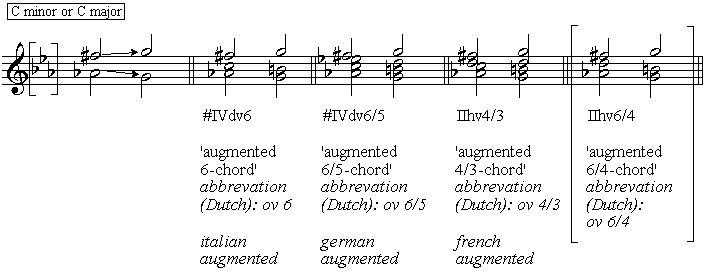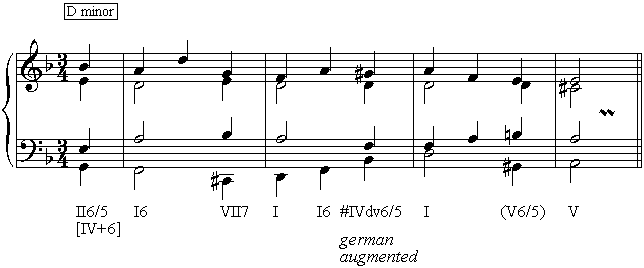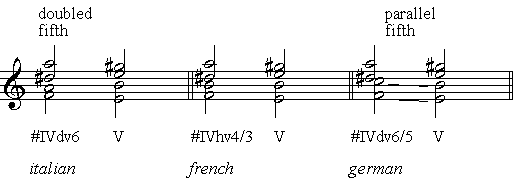|
||
| Section E. is not at all complete yet. In the moment only this is available: altered chords / sections 1-3, 5, and part of section 9 | SWITCHTO THE DUTCH VERSION |
| 2. diminished third on #4^:
double diminished on #IV en hard diminished on II
As already mentioned in the preceding section: The diminished third 'around' the fifth of the key is much more common than diminished thirds 'around' the root and the third of the key. We encounter the diminished third between #4^ en (b)6^ in the following chords: |
| example 8 |
 |
The above chords can appear in C minor and in C major - although they
are in C minor definitely 'more diatonic'... In C major they are in fact
'borrowed' from the parallel minor key: the third and the sixth are both
minor (in example 6: the notes Eb en Ab).annThe
chords are these:
Maybe
it is handy, when you are constructing #IVdv or IIhv yourself, to use these
mnemonics:
double
diminished op #IV:
(in
minor keys you can skip the first step...)
hard
diminished onII:
(in
minor keys you can skip the first step...)
In example 9 below, these steps are shown schematically: |
| example 9 |
 |
| augmented 6-, 6/5-
and 4/3 chord
double diminished and hard diminished op #IV respectively II are most commonly used in specific inversions, namely these inversions in which the sixth of the key is in the bass. as a result, in these inversions the diminished third appearsalways inverted, as augmented sixth . In these specific inversions the chords can also be labelled as 'augmented ...chord' (in which on the position of the dots the inversion is mentioned). N.B.: This involves certainly not augmented chords, but chords in which an augmented sixth sounds between the bass and one of the higher voices. The inversions are:
|
| example 10 | ||||||
| You can listen to the examples below. In each example you first hear a short melodic fragment and the tonic triad, and then the two chords as noted in the example. | ||||||
|
|
||||||
 |
In by far most cases these
'augmented' chords (as the other inversions of #IVdv and IIhv as well)
resolve to the dominant - normally V, V7 of I6/4.
Functionally, #IVdv
en IIhv on on the one hand are rather similar to secondary dominants
(because
of the leading tone to 5^); on the other hand, there are also similarities
with the subdominant, in particular caused by the presence of the (minor)
6^ in both chords. Therefore they are often called: altered subdominants.
I maintain that their function is somewhere in between secondary dominant
and subdominant - which may also be reflected in how #IVdv and IIhv can
be approached:
|
| example 11 | |||
| You can listen to the examples below: | |||
|
|
|||
 |
| Especially in minor keys #IVdv or IIhv after VI is well possible: we could see the altered chord then as altered subdominant as well, as we can say that #IVdv or IIhv 'replace' an 'ordinary' subdominant: |
| example 12 | ||
| You can listen to the examples below: | ||
|
|
||
 |
| Occasionally, #IVdv or IIhv is not followed by a dominant chord, but by the tonic (normally I); in that case, the altered chord is most like a subdominant chord; a progression like #IVdv6/5 --> I sounds somewhat like a plagal cadence. The augmented sixth is hereby actually resolved 'wrongly' or 'incompletely': Though #4^ moves to 5^ (as it should), 6^ leaps to 1^ (see example 11 below: G# in the soprano resolves correctly, but Bb in the bass leaps to D, instead of moving stepwise to A): |
| example 13 | ||
| You can listen to the example below: | ||
|
|
||
 |
Some remarks about doubling
and
about resolutions
of augmented 6-, 6/5- en 4/3-chords to the dominant:ann
|
| example 14 | ||
| You can listen to the example below: | ||
|
|
||
 |
||
| example 15 |
| 000 | usage of Italian, German and French augmented chords (augmented 6, 6/5 and 4/3) in a typical situation: to prepare the dominant / V( in a context that we could imagine as: end of the central section of a development section (the E at the end could mark the beginning or the dominant pedal point), or for example the end of a transitions, or a place right before another important caesura in a composition. Instead of after I6 the altered chord could equally well stand after IV6 or II4/3, or after VI.ann |
| a |
Italian
augmented (augmented 6 chord /(#IVdv6):
|
| b |
French
augmented (augmented 4/3 chord /(#IIhv4/3):
|
| c |
German
augmented (#IVdv6/5 / augmented 6/5chord ):
|
| In compositions the parallel fifth between
# IVdv6/5 and V is avoided (notwithstanding that it is permitted). The
most common way is to let V be preceded by I6/4 (see example 16 a). Another,
less standard trick: the seventh of #IVdv6/5 ascends to the seventh
of V7 - actually the voice leading is then 'incorrect' (see example 16c).ann
In the progression #IVdv6/5 - V in major keys the seventh of #IV is quite often notated as major sixth - see the third example in 16a. This has a reason in the voice leading: It seems logical to reach the third in I6/4 from a leading tone (in the example: B# -> C#); but as this third is in this context no more than a suspension of the fifth of V there is no reason - even with this notation - interpret the chord other than as #IV: The chord sounds just as #IV, and 'behaves' accordingly as well.ann |
| example 16 |
| a000 | ||||||
| b |
To equation:
#IVdv6/5
--> V,
with
parallel fifth. See examples 14, 15c and example 16
c as well.
|
|||||
|
||||||
| c |
Especially
in the 19th century this is a common "trick" as well: the seventh
of
# IVdv6/5
ascends
to the
seventh of V7. Infact: 'wrong' voice leading ... ann
|
|